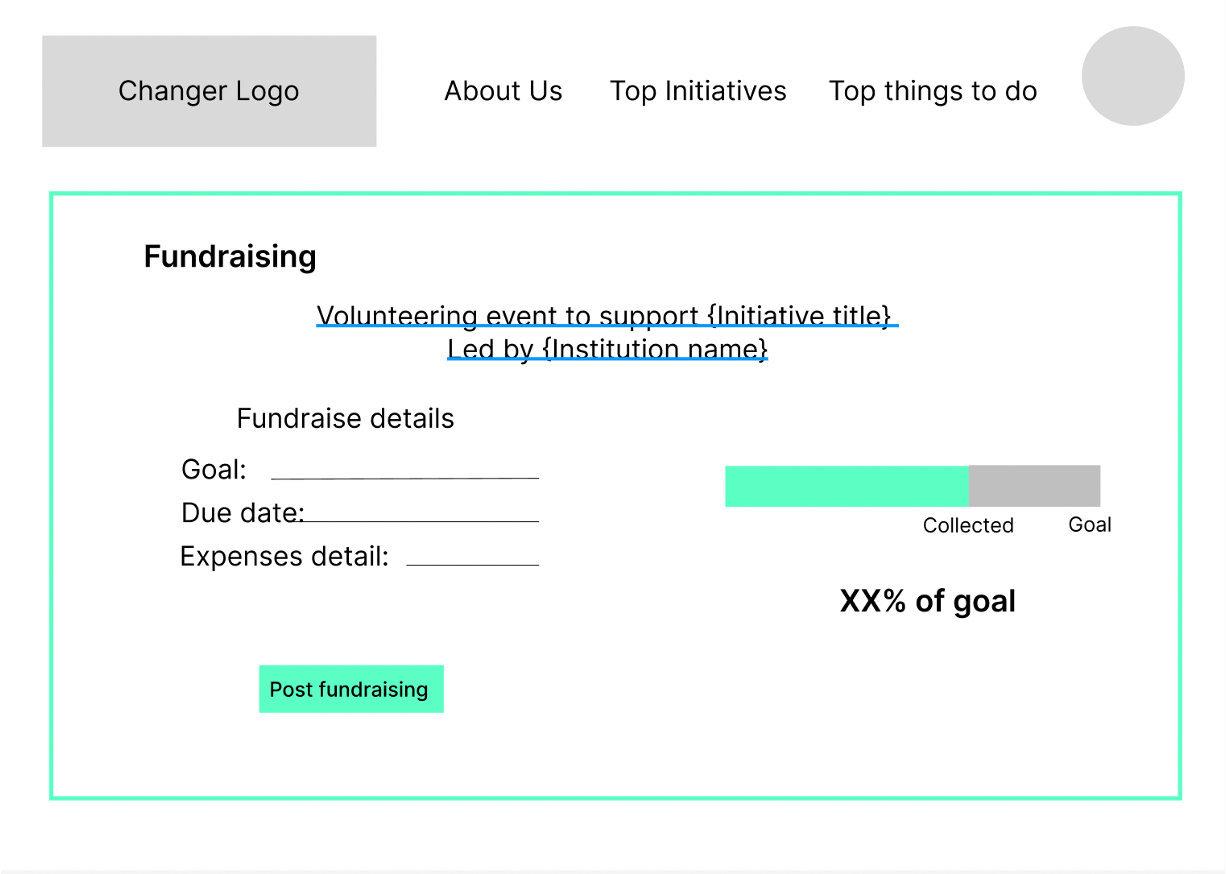Changer
My final project for Product School’s Product Management Certification consisted on creating a solution to best serve users’ needs.
I came up with Changer, a platform to allow people concerned about climate change to join a community and take impactful actions to mitigate it.
Here, I’ll walk you through the ideation process of that solution: what problem I found, what user personas and user stories my proposed solution would serve, its features, how I’d apply features prioritization according to their impact, as well as the go-to-market plan.
The Problem
I based my initial research on the following questions:
-
I limited my research to US adults. Based on an extensive survey conducted to such population from 2008 to 2021 by the Climate Change in the American Mind project led by Yale and George Mason University, more than half American adults (65%) are worried about global warming. My assumption was that the same population is concerned about climate change, which is caused by global warming.
Conclusion: Yes (US adults are concerned about climate change)
-
An excerpt of the same survey’s results shows that:
- 77% think school should teach about global warming.
- 71% believe global warming will harm future generations
- Above 50% of respondents support changes to multiple policies to mitigate global warming
The answers are not conclusive about whether the respondents take actions to tackle the problem, but they show a belief that current and future students should be taught about global warming. In that vein, there might be some willingness of adults with children to get their kids informed about climate change. (Further research would be needed to determine if US adults, as individuals, take actions to mitigate climate change or are willing to do so.)
In addition, the first and last bullets let us know that American adults rely in schools (77%) or other institutions (50%+) to teach and promote policies to mitigate global warming.
Conclusion: While more than half American adults rely on institutions to mitigate global warming (and therefore, climate change), it is not clear whether or not this population take actions to mitigate that issue, but they might support their kids to be informed about the topic.
-
I brainstormed a list of sources that inform about climate change.
News articles
Research publications
Social media posts and groups
Individual websites of:
Institutions
Startups
Policy makers
NGOs
Funds
While they all inform about the issue and many initiatives around it, I consider it can be difficult for the public to get personalized, relevant, and engaging climate change mitigation content from so many sources.
News articles feature climate-related events only when they happen, and the focus shifts when the next big story comes.
Research publications don’t have an engaging format and while its content is extremely interesting, is too long to read.
Social media posts and groups may only contain comments, with no real call to action and no consequences, they may also lack accuracy. Individual websites show amazing initiatives, but they are dispersed, and one must access each of them to know what’s happening.
This research led me to define the problem I should focus on:
“People find it overwhelming to get impactful recommendations to fight climate change.”
User Personas
Once I found the problem, it was time to think about the User Personas my solution will have to serve.
As a reminder:
The primary persona has the problem mentioned and is extremely unhappy with current solutions.
The secondary persona has found some way around the problem but given that she isn’t extremely happy with the solution she knows, she would be willing to evaluate my solution.
The third persona would most likely evaluate my solution if offered a promotion.
It’s really important to imagine how user personas look like, what are their backgrounds, goals, needs, pain points and preferences. So, let’s take a look at them:
-
Young individual very concerned about climate change.
Likes to be informed about the latest news in the topic.
Actively evangelizes environmental actions in their communities (via social media, word of mouth, or volunteering events) but still considers these actions to be disperse and not impactful enough.
-
Young working individual who takes at least one environmentally friendly action regularly (for example: recycling, composting, driving a hybrid or electric car).
Concerned about climate change but doesn’t like the hassle of researching about it or don’t have the time to do it.
Would like a single source of truth to learn what else she can do to fight climate change.
May not have time for volunteering, but may be willing to donate.
-
Young adult who only gets really concerned about climate change when he experiences or listens about unusual climate-related consequences.
Tends to forget about the topic when the effects go away. Nevertheless, the unusual effects are increasing, and this persona would consider taking actions to fight climate change if they are easy or entertaining to do.
Prioritization
After identifying the user personas, I had a better idea of the pain points that my solution will have to solve. Given that resources are most likely to be limited in any project (in this case, the time to work on the solution), my next step was to prioritize the most impactful pain points over the personas.
I applied the Kano Model because it allows me to categorize the users’ expectation level I’ll be covering with certain features. With this model in mind, I asked which solution would cover the users’ basic expectations, which would satisfy them, and which would delight them. Let’s see what this categorization showed:
Basic expectations
The primary persona wants to shorten time to organize volunteering events.
The secondary persona wants to shorten time to know the new habits she needs to develop.
The third persona wants to shorten time to get to be informed about climate change in an engaging way.
Conclusion: A solution that minimizes the time the personas spend to become involved in climate change initiatives would cover their basic expectations.
Satisfiers
The primary persona would like to maximize reach and attendance of volunteering events.
The secondary persona would like to seamlessly donate for the cause she considers best.
The third persona would like to receive engaging content to share with friends.
Conclusion: Each persona has different satisfiers.
Delighters
The primary and secondary personas would like to track their contribution.
The third persona would like to expand his social network.
Conclusion: Primary and secondary persona have the same delighter expectations, different from the one the third persona has in mind.
User Stories and Features
I developed 5 user stories, which are the foundations for the features the product will have, and labeled them according to the Kano Model caveats so anyone can easily recognize the priorities they’ll receive during the product development cycle. Check out the user stories, features’ summaries, as well as the first wireframes for features that cover basic expectations:
User Story #1
“As an activist, I want to organize volunteering events in a shorter time so that I can have a better work-life balance.”
Feature 1.1.: Summarized curated content
1.1. Feature to weekly show summarized, engaging, and curated info about current initiatives to fight climate change from prestigious or innovative institutions, as well as personalized content recommendations. [Covers basic expectation]
Feature 1.2.: Request institutional approval to organize volunteering events
1.2. Feature to request approval to organize volunteering events to support the curated initiatives presented weekly (led by the activist and approved by an institution). By default, these events suggest places near the organizer, but will have the option to change the location. [Covers basic expectation]
Feature 1.3.: Register volunteering events’ details
1.3. Feature to get approval as organizers from environmental institutions. [Covers basic expectation]
Feature 1.4.: Fundraising
1.4. Feature to initiate fundraise to cover volunteering events expenses*. [Covers basic expectation]
*Changer will collect a 5% platform fee from these fundraisers to cover platform expenses. (GoFundMe charge the same %)
User Story #2
“As an activist, I want the volunteering events I organize or support to have more reach so that they get higher attendance.”
Feature 2.1.: Organize multiple events
2.1. Feature that expands organization of volunteering events to support parallel events for the same cause in different places. [Satisfier]
Feature 2.2.: Networking between activists and institutions
2.2. Feature to connect activists with institutions to get know-how and contacts to increase reach. [Satisfier]
User Story #3
“As a single source of truth seeker, I want an effective list of actions I can do to fight climate change so that I don’t spend much time researching about it and I can teach them to my child.”
Feature 3.1.: Short initial survey
3.1. Feature when registering to the platform: short survey to know actions users already do and preferences of future actions (develop new habits or donate). [Covers basic expectation]
Feature 3.2.: Recommended list of actions
3.2. Feature to suggest list of actions user can do next. [Covers basic expectation]
User Story #4
“As a single source of truth seeker, I want to periodically be able to easily choose environmental initiatives from a single list, donate to them and receive news about their impacts so that I know I’m contributing to climate change mitigation in the best way possible for me.”
Feature 4.1.: Show top 5 initiatives
4.1. Feature that shows top 5 initiatives with option to show them according to: recommended by most impactful, proximity, cause, about-to-end. [Satisfier]
Feature 4.2.: Show impact history
4.2. Feature that shows past contributions (donations or attendance to volunteering events) and final impact of the whole initiative. [Delighter]
Feature 4.3.: Track impact of ongoing actions
4.3. Feature that shows ongoing contributions with updated impact of the whole initiative. [Delighter]
User Story #5
“As a reactive environmentalist, I want to know the most engaging and effortless way to contribute to climate change mitigation so that I also have fun doing it.”
Feature 5.1.: Receive engaging content
Apart from features 1.1. Show summarized curated content; 3.1.: Short initial survey; and 3.2. Recommended list of actions, the next feature is needed.
5.1. Feature to prioritize summarized content with short videos instead of just text on home page. [Covers basic expectations]
Go-To-Market
With these features in mind, I suggested the product’s first iteration to be a website platform with curated content from environmental institutions showing its top initiatives and suggestions that users can support or apply in their routines. Given that this would be a new product, the website format allows to use SEO strategies to get traffic to the website and let users discover it.
At a later stage, I would also suggest to develop an app version to allow young users to easily access it on the go. The following is the GTM plan for the first iteration:
Summary and Next Steps
Changer can be a relevant source of truth for the personas mentioned. Alleviating their pain would let our users be informed of the initiatives they can participate on and engage on a larger community of climate change fighters to maximize their individual impact on climate change mitigation while saving time they might have spent figuring out how to help.
As mentioned, the platform will first charge a platform fee from fundraising events (similar as GoFundMe does nowadays).
In a later stage, the product can offer environmental-related companies or contractors the chance to participate in volunteering events as a way for them to establish brand association with our cause. We would collect participation fees for this.















